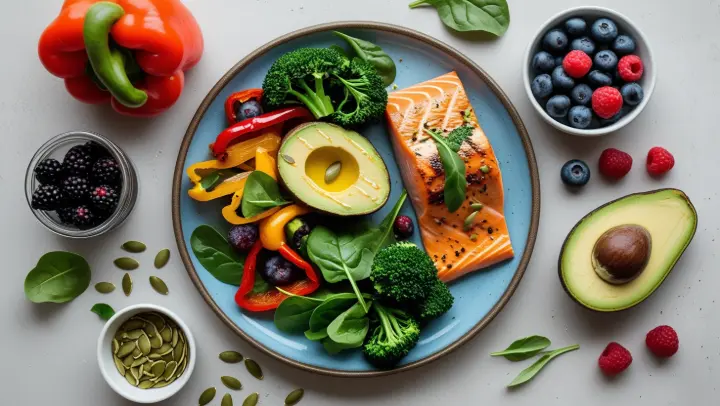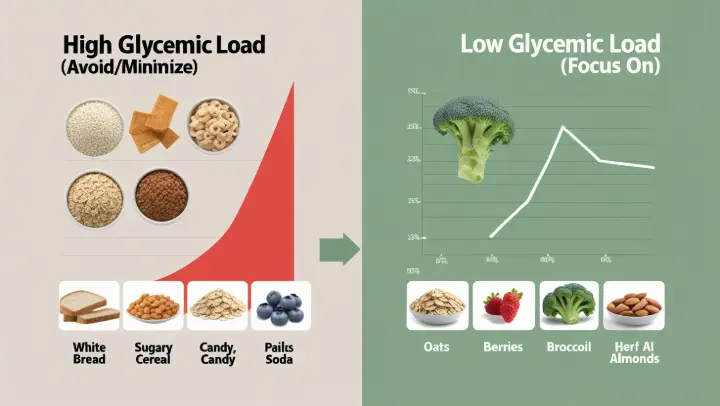The PCOS Plate: Your Fork as a Powerful Tool for Hormonal Harmony
Let's talk about something millions of women navigate daily: Polycystic Ovary Syndrome (PCOS). If you're reading this, chances are you're intimately familiar with its frustrating symphony – irregular periods, stubborn weight, acne, unwanted hair growth, and that lingering fatigue. You might have tried countless diets, felt overwhelmed by conflicting advice, or simply wondered, "What should I actually be eating?" Here's the empowering truth: Your diet isn't just about calories; it's one of the most potent tools you have to directly influence your PCOS symptoms and reclaim hormonal balance.
PCOS Diet Plan
Overhead photo of a vibrant, abundant plate illustrating the core PCOS nutrition strategy: 50%+ colorful non-starchy vegetables (spinach, peppers, broccoli), 25% lean protein (grilled salmon/tofu), 25% complex carbs (quinoa/sweet potato), topped with healthy fats (avocado, pumpkin seeds, olive oil drizzle), plus berries. Conveys nourishment, balance, and abundance – not restriction. Bright, fresh, inviting style

Forget fads, extremes, and one-size-fits-all meal plans. Managing PCOS through nutrition is about understanding the unique wiring of your body and making strategic, sustainable choices. It's less about deprivation and more about powerful nourishment.
Decoding the PCOS Puzzle: Why Food Matters So Much
PCOS isn't just an ovarian issue; it's a whole-body metabolic and endocrine condition. Three key players heavily influenced by diet are:
Insulin Resistance (The Star Player): This is arguably the most crucial factor for the majority (up to 70%) of women with PCOS. Imagine insulin as the key that unlocks your cells to let glucose (sugar) in for energy. In insulin resistance, the locks get rusty. Your pancreas pumps out more insulin (hyperinsulinemia) to force the glucose in. This excess insulin wreaks havoc:
Fuels Androgen Production: High insulin signals the ovaries to produce more testosterone and other androgens, driving acne, hirsutism (excess hair), and hair loss.
Blocks Ovulation: It disrupts normal follicle development, leading to irregular or absent periods.
Promotes Fat Storage: Especially around the abdomen (visceral fat), making weight loss incredibly challenging and further worsening insulin resistance – a vicious cycle.
Diet Connection: What you eat directly impacts blood sugar and insulin levels. Choosing foods that cause rapid spikes requires more insulin, worsening resistance. Choosing foods that release glucose slowly keeps insulin steadier.
Inflammation (The Silent Fire): PCOS is often linked with chronic, low-grade inflammation. This inflammation isn't just about swelling; it can damage cells, worsen insulin resistance, and contribute to symptoms like fatigue and even long-term health risks (like heart disease).
Diet Connection: Certain foods (like highly processed items, sugary drinks, excessive saturated/trans fats) can fan the flames of inflammation. Others (like colorful fruits, vegetables, fatty fish) actively fight it.
Gut Health (The Emerging Frontier): Research increasingly points to the gut microbiome playing a role in PCOS. An imbalance in gut bacteria (dysbiosis) may influence inflammation, insulin sensitivity, and even hormone metabolism.
Diet Connection: Fiber is the preferred fuel for beneficial gut bacteria. A diet rich in diverse plant foods supports a healthier gut ecosystem.
Building Your PCOS Power Plate: Principles, Not Prescriptions
There's no single "PCOS diet," but robust scientific evidence and clinical experience point to core principles that form the foundation of an effective eating pattern:
Prioritize Low Glycemic Load (GL): This is the golden rule for tackling insulin resistance. It goes beyond just "low carb" to consider how quickly and how much a food raises blood sugar.
Focus on: Non-starchy vegetables (broccoli, spinach, peppers, zucchini, leafy greens – aim to fill half your plate!), high-fiber fruits (berries, apples, pears in moderation), whole intact grains (quinoa, oats, brown rice, barley - choose minimally processed), legumes (beans, lentils, chickpeas).
Minimize/Time Carefully: Refined carbohydrates (white bread, pasta, pastries, sugary cereals), sugary drinks (soda, juice, sweetened coffees), sweets. If you have them, pair them with protein, fat, and fiber (e.g., a small cookie after a meal with protein and veggies, not on an empty stomach).
Why it Works: These high-fiber, complex carbs break down slowly, leading to a gradual rise in blood sugar and requiring less insulin. Stable blood sugar means fewer energy crashes and cravings.
Example Swap: Instead of sugary cereal with low-fat milk, try Greek yogurt (high protein) topped with berries (fiber, antioxidants) and a sprinkle of nuts (healthy fat, fiber). Instead of white rice, opt for quinoa or cauliflower rice.
Left shows 'High GL Foods' (white bread, sugary cereal, candy, soda) with a sharp red spiking arrow graph. Right shows 'Low GL Foods' (oats, lentils, berries, broccoli, almonds) with a gentle green steady line graph. Clear labels and a brief caption: 'Choose steady energy (Low GL) over sugar spikes (High GL)'.

Embrace Healthy Fats: Fat is not the enemy! The right fats are essential for hormone production, reducing inflammation, and satiety.
Focus on: Monounsaturated fats (avocados, olive oil, nuts like almonds/walnuts, seeds like chia/flax/pumpkin), Omega-3 fatty acids (fatty fish - salmon, mackerel, sardines; walnuts, chia seeds, flaxseeds - grind these for better absorption!).
Limit: Saturated fats (found in red meat, full-fat dairy - choose lean cuts and moderate portions), avoid Trans fats (found in many processed/fried foods - check labels!).
Why it Works: Omega-3s are potent anti-inflammatories. Healthy fats slow digestion, helping with blood sugar control and keeping you fuller longer. They're crucial for absorbing fat-soluble vitamins (A, D, E, K).
Power Up with Protein: Protein is essential for building and repairing tissues, including muscle (which improves insulin sensitivity!). It also promotes satiety and helps stabilize blood sugar.
Focus on: Lean sources (chicken, turkey, fish, eggs), plant-based proteins (tofu, tempeh, edamame, lentils, beans), moderate amounts of lean red meat. Include protein at every meal and snack.
Why it Works: Protein requires more energy to digest than carbs or fat (thermic effect), supports muscle mass (key for metabolism), and significantly blunts blood sugar spikes when paired with carbs.
Example Meal: Large salad (non-starchy veggies) topped with grilled chicken or salmon (protein + healthy fat), chickpeas (fiber + protein), avocado (healthy fat), and olive oil & vinegar dressing.
Become Fiber Focused: Aim for 25-35 grams daily. Fiber is PCOS's best friend!
Sources: Vegetables (all kinds!), fruits (especially berries, pears, apples with skin), legumes (beans, lentils), whole grains (oats, quinoa, barley), nuts, seeds (chia, flax, psyllium husk).
Why it Works: Slows sugar absorption (improves insulin sensitivity), feeds beneficial gut bacteria (improves gut health and may aid hormone balance), promotes satiety, aids digestion. Soluble fiber (oats, beans, apples) is particularly good for blood sugar and cholesterol.
Choose Anti-Inflammatory Foods: Load up on nature's inflammation fighters.
Focus on: Vibrantly colored fruits and vegetables (berries, cherries, oranges, leafy greens, broccoli, tomatoes - rich in antioxidants), fatty fish (omega-3s), turmeric (contains curcumin - add black pepper for absorption!), green tea, extra virgin olive oil, nuts, seeds.
Minimize: Processed foods, fried foods, sugary drinks, excessive red meat, refined carbs – these tend to be pro-inflammatory.
Mind Your Minerals:
Magnesium: Often low in PCOS. Crucial for insulin sensitivity and nerve/muscle function. Found in leafy greens, nuts, seeds, legumes, avocados, dark chocolate (85%+!).
Chromium: May improve insulin sensitivity. Found in broccoli, grapes, whole grains, brewer's yeast (check with doc if supplementing).
Inositol: A B-vitamin like compound showing significant promise in PCOS research (especially the Myo-inositol form). Studies suggest it improves insulin sensitivity, ovulation, and metabolic markers. Found in fruits, beans, grains, nuts, but often supplemented under guidance.
Putting it All Together: A Day on the PCOS Plate (Example)
Breakfast: Veggie scramble (2 eggs + spinach, mushrooms, peppers) cooked in olive oil + 1/2 avocado + small handful of berries. (Protein, Healthy Fats, Fiber, Low GL)
Snack: Apple slices with 1-2 tbsp almond butter. (Fiber, Healthy Fat, Protein)
Lunch: Large mixed greens salad with grilled chicken, black beans, cucumber, tomatoes, pumpkin seeds, and a lemon-tahini dressing. (Protein, Fiber, Healthy Fats, Low GL, Anti-inflammatory)
Snack: Small container of plain Greek yogurt topped with chia seeds and a few raspberries. (Protein, Healthy Fats, Fiber)
Dinner: Baked salmon with roasted broccoli and Brussels sprouts drizzled with olive oil, and a small serving of quinoa. (Omega-3s, Protein, Fiber, Healthy Fats, Low GL, Anti-inflammatory)
Essential Non-Food Allies:
Nutrition is powerful, but it works best alongside:
Movement: Regular exercise (especially strength training and moderate cardio) is non-negotiable for improving insulin sensitivity. Aim for 150 mins/week moderate activity + 2 strength sessions.
Stress Management: Chronic stress raises cortisol, which can worsen insulin resistance and inflammation. Prioritize sleep (7-9 hours!), explore mindfulness, yoga, deep breathing.
Hydration: Drink plenty of water throughout the day. Sometimes thirst mimics hunger.
Consistency & Patience: This isn't a quick fix. It's a sustainable lifestyle shift. Focus on progress, not perfection. Hormonal changes take time.
The Takeaway: Empowerment on Your Plate
Managing PCOS through diet isn't about punishment or impossible restrictions. It's about harnessing the incredible power of food as medicine. By focusing on whole, minimally processed foods rich in fiber, healthy fats, lean protein, and anti-inflammatory compounds, you directly address the core drivers of PCOS – insulin resistance and inflammation.
Think of it as building a symphony of nourishment. Each low-GL meal, each serving of vegetables, each healthy fat, and each mindful choice contributes to a more harmonious hormonal environment. Combine this with movement, stress reduction, and good sleep, and you have a powerful, evidence-based strategy.
You are not powerless against PCOS. Your fork is a potent tool. Start where you are. Make one positive swap today. Celebrate the small wins. Listen to your body. Work with a registered dietitian specializing in PCOS or hormonal health if you need personalized guidance. This journey is about nurturing yourself, reclaiming your vitality, and discovering that feeling better is absolutely possible, one nourishing bite at a time. Your body deserves this profound level of care.